Platypus QuickDraw Microfilter Review
The Platypus QuickDraw Microfilter is a 2.2 oz / 62 g hollow-fiber membrane water filter that removes bacteria and protozoa from water sources. It’s designed for simplicity and ultralight backpacking—certainly something hikers use on trails such as the Pacific Crest Trail and the Continental Divide Trail. However, it’s also a great choice for shorter backpacking trips or as something to have in your pack “just in case.”
It can be purchased as a system (including the filter and a 1-liter Platypus bag) or as a standalone filter. The filter can be attached to various water containers, including Smartwater/LIFEWTR bottles, most Platypus bottles, and other typical 28mm PET soda/water bottles. Because it uses a hollow-fiber membrane filter, it is susceptible to freezing and/or impact damage. Still, unlike many other hollow-fiber membrane filters, the QuickDraw can be field-tested for integrity.
Testing Conditions
I used the Platypus QuickDraw Microfilter on the 800 mi / 1,287 km Arizona Trail (AZT). There were many questionable water sources along the AZT, from smelly cow ponds to scummy green wildlife tanks. Needless to say, I definitely put the Platypus Quickdraw to the test on the AZT.
The Specs
- Color: Blue
- Weight: 2.2 oz / 62 g
- Filter Medium: Hollow-fiber membrane
- Housing Material: ABS plastic
- Dimensions: 5 x 1.8 in / 12.7 x 4.6 cm
- Cartridge life: 1,000 liters
- Country of Origin: USA
- MSRP: $29.95
The Features
- Packs small for easy access anywhere on or in your packing system
- I/O dual-thread design allows filter cartridge to attach to the QuickDraw Reservoir, SmartWater bottles, the Platy Hoser, most Platy bottles, and certain common 28mm PET soda/water bottles.
- Hollow fiber cartridge filters up to 3 liters per minute (according to Platypus)
- Shake-to-clean or tool-free backflush methods
- The attached clean side cap opens and creates a seal when closed.
- Individually tested to meet all EPA & NSF guidelines for the removal of 99.9999% of bacteria and 99.9% of protozoa.
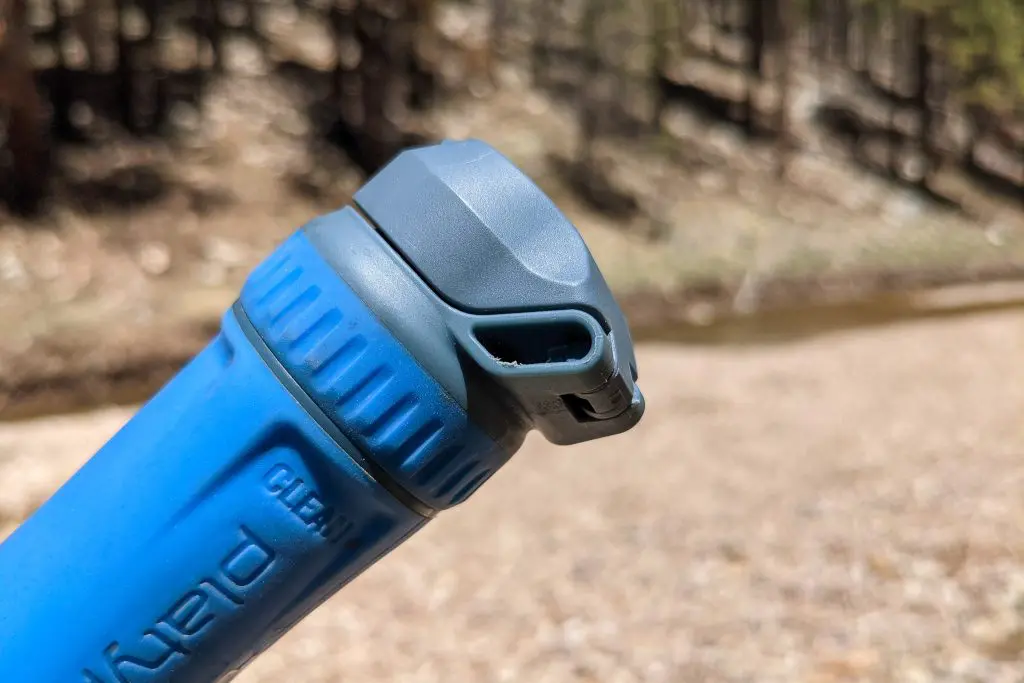


The Good
The Weight
The Platypus QuickDraw Microfilter weighs in at 2.2 oz / 62 g – nearly 1 oz / 28 g lighter than the Sawyer Squeeze. It’s certainly a competitor in the ultralight backpacking world in terms of weight. Unless you’re looking to treat with bleach or you’re out somewhere that doesn’t require you to filter, you will be hard-pressed to find a lighter, better-performing filter.
The Compatibility
The QuickDraw can be purchased as a system or as a standalone filter if you don’t want/need a dirty bag. You can attach the Platypus QuickDraw directly to a variety of water containers. This includes Smartwater/LIFEWTR bottles (a popular choice among thru-hikers), most Platypus bottles (as you would expect from a Platypus product), and other common 28mm PET soda/water bottles. The fact that you do not need a specific bottle/bladder to use the QuickDraw makes it an attractive choice as a water filter.
The Caps
The QuickDraw comes with a cap on both the clean and the dirty end of the filter. The clean end has a hinged cap that appears to be quite durable and shows no signs of breaking off (this was a concern of mine when I first got the QuickDraw). The dirty side has a screw-on cap that fits tightly enough for me to not worry about water leaking out while the filter is stored. Since this is a hollow-fiber membrane filter, it is recommended that you keep it warm in near-freezing temperatures. I choose to sleep with the filter in my sleeping bag and the two caps never leaked during the night.
The East of Use
Using the Platypus QuickDraw Microfilter is simple – screw it onto your water reservoir and squeeze. You can squeeze the water into a clean reservoir or directly into your mouth. The one complication? If you’re using a rigid container (like a Smartwater bottle), you’ll have to let some air into your bottle while filtering (let it reinflate) to successfully (or at least without maximum frustration) empty the dirty water through the filter into your clean receptacle.
The Testing
Yes, the QuickDraw can be rendered ineffective if it freezes or is dropped. However, the QuickDraw is also the first hollow-fiber membrane filter (I’ve encountered) that can be field-tested to check whether it has been compromised. According to the instructions, you fill your reservoir with 1 liter of water, attach it to the filter, filter half, flip the reservoir upside down so the bottom of the filter is in contact with air inside the empty reservoir, squeeze firmly to push air through the filter, and then you look for a steady stream of bubbles. If you see bubbles, your filter is compromised and is no longer filtering your water.
The Packaging
Something that might easily be overlooked but that I certainly see as a benefit to the QuickDraw is the fact that when you buy the filter by itself (not the system that includes a Platypus bag), it comes with just the filter, nothing else. A lot of other filters include a bunch of junk that most people (myself included) won’t even use and that ends up just becoming trash. The QuickDraw is not burdened by this problem; everything you get with the filter (i.e. the filter itself), is all you need to use the filter (with the exception of a reservoir for your water).



The Okay
The Flow Rate
The Platypus QuickDraw Microfilter has a decent flow rate out of the box. Platypus promises 3 liters per minute, but this number has to come from “ideal testing conditions” and with a new filter. After repeated use (and backflushing), you can expect considerably less. I completed the Arizona Trail alongside someone using a Sawyer Squeeze, and I found our flow rates to be about the same overall.
The Backflushing
Backflushing is the process by which you run water backward through the QuickDraw to remove all the gunk that has been caught inside while filtering. The bad news? You have to backflush (if you want to keep your filter performing with a reasonable flow rate). The good news? You don’t need any special tools or accessories to backflush your QuickDraw. Simply take the clean side, press it up against a water bottle (with the cap removed) to create a seal, and squeeze your water bottle. Alternatively, you can shake the filter while it’s attached to a bottle to clean it out, but this doesn’t work as well as backflushing.

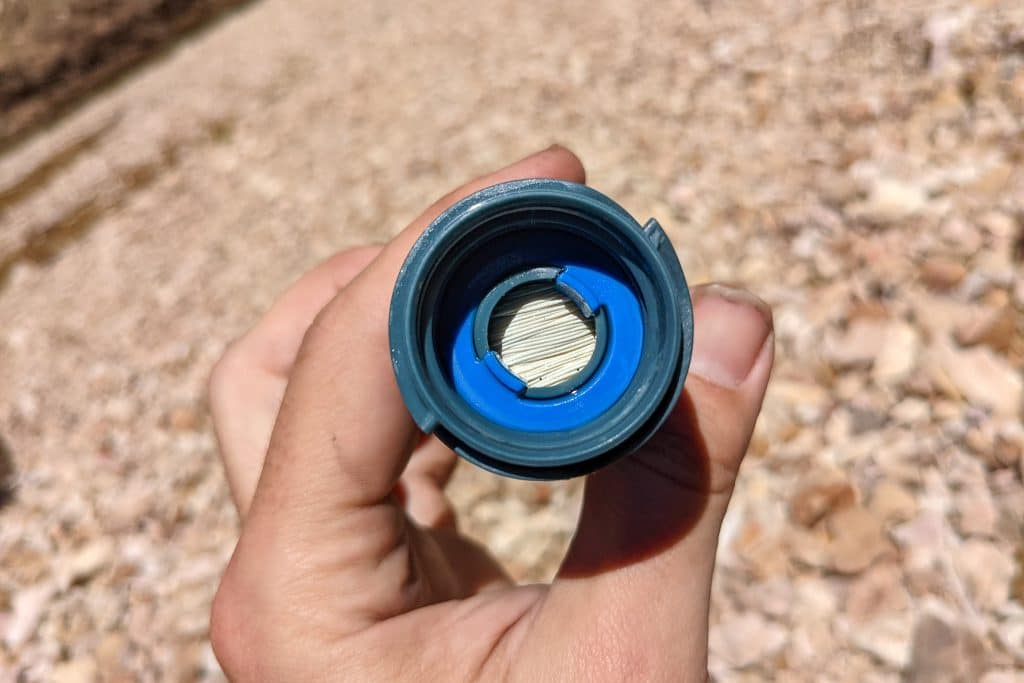

The Bad
The Freezing
One of the major drawbacks to the Platypus QuickDraw, as with all hollow-fiber membrane filters, is the fact that it can freeze. Typically, this won’t be an issue for most three-season backpacking. The solution is to keep your filter in your sleeping bag with you at night (made easier by the two caps on the QuickDraw). However, if you’re traveling in below-freezing temperatures during the day as well, you may want to look elsewhere for a filter that isn’t as susceptible to the cold. That said, you can at least test the QuickDraw to see if it has been compromised.
The Viruses
The other drawback, which I pointed out earlier, to the QuickDraw is that it does not treat for viruses. That said, viruses are not an issue in many parts of the world, and there is certainly no reason to have to treat for viruses if you are going to be filtering water in an area where bacteria and protozoa are your only concerns (the case for most of the United States). However, I still feel it is worth pointing out that the QuickDraw will not remove viruses from your water sources (like your hotel’s tap water in Mexico).

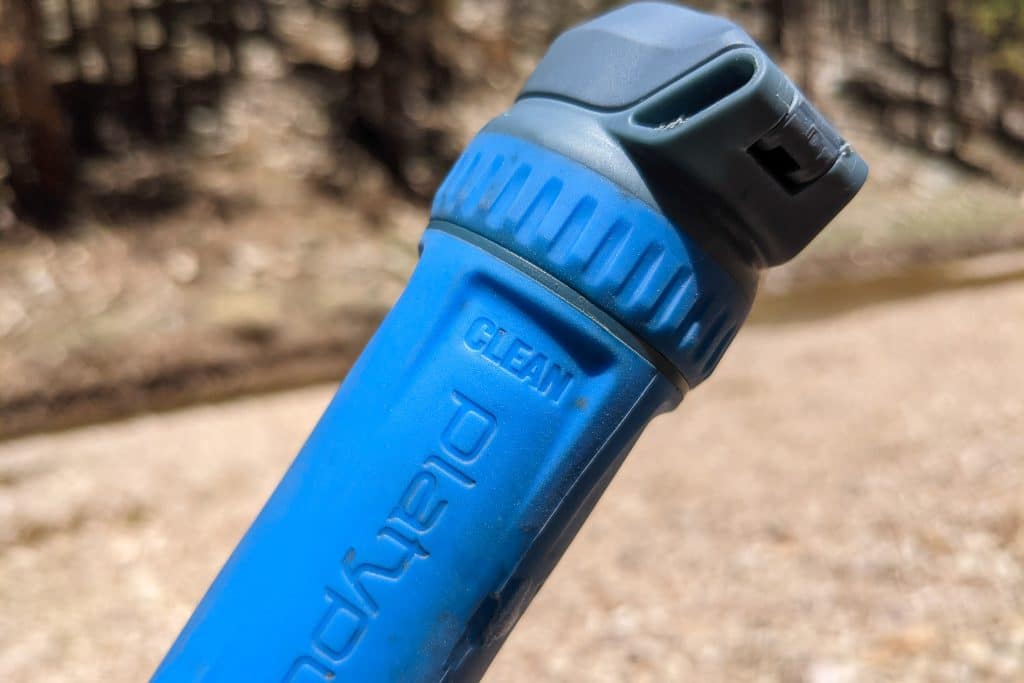

Who is it for?
Beginner Backpackers
If you’re new to the idea of backpacking, there’s nothing wrong with a Platypus QuickDraw Microfilter. It’s actually one of the easiest filters to use and is one of the few items of gear that both veterans and newcomers can appreciate at the same time.
Weekend Warriors
The Platypus QuickDraw Microfilter will serve you well as a weekend warrior so long as you’re not going to be out primarily in below-freezing conditions or need to treat for viruses (the QuickDraw does not remove viruses).
Thru-Hikers
The Platypus QuickDraw Microfilter is new to the scene, but I imagine that it will be making a splash in the thru-hiking community. It’s been a while since we’ve seen any innovation on the current ultralight filter offerings, and I think the QuickDraw definitely is worth considering for your next thru-hike.
A Note for Couples: If you are traveling as a couple and plan to be filtering a lot of water, I would suggest that you each have your own Platypus QuickDraw Microfilter. Using only one to filter large amounts of water for two people could quickly become frustrating and could cut significantly into your day. I would also suggest considering something more convenient (but heavier), like the Platypus GravityWorks.
Popular Alternatives
| Water Treatment | Price | Weight | Type | Dimensions | Medium | Removes |
|---|---|---|---|---|---|---|
| Platypus QuickDraw | $30 | 2.2 oz / 62 g | Squeeze/Straw | 5 x 1.8 in / 12.7 x 4.6 cm | Hollow fiber | Protozoa and bacteria |
| Sawyer Squeeze | $37 | 3 oz / 85 g | Squeeze/Straw | 2 x 5 in / 5 x 13 cm | Hollow fiber | Protozoa and bacteria |
| Sawyer Micro | $29 | 2.5 oz / 71 g | Squeeze/Straw | 1 x 6 in / 2.5 x 15 cm | Hollow fiber | Protozoa and bacteria |
| Sawyer MINI | $20 | 2 oz / 57 g | Squeeze/Straw | 1 x 5 in / 2.5 x 13 cm | Hollow fiber | Protozoa and bacteria |
| Katadyn BeFree | $25 | 2.3 oz / 65 g | Bottle | 11.3 x 3.5 x 2.8 in / 29 x 9 x 7 cm | Hollow fiber | Protozoa and bacteria |
| Aquamira | $15 | 3 oz / 85 g | Drops | N/A | Chlorine dioxide | Protozoa, bacteria, viruses |
| Platypus GravityWorks | $100 | 10.9 oz / 309 g | Gravity | 3 x 7.4 in / 7.6 x 18.8 cm | Hollow fiber | Protozoa and bacteria |
Conclusion
The Platypus QuickDraw Microfilter is certainly worth taking a look at if you’re wanting a simple, lightweight, three-season solution for water filtration. It’s similar to other offerings on the market but has enough new features (and is lightweight enough) that I’m sure we’ll be seeing it widely adopted in the coming years.
Whether you’re a beginner backpacker or a seasoned thru-hiker (or other enjoyer of the outdoors), the QuickDraw will do everything you need it to at an individual level (for groups, it’s probably not the best choice).
Check out the Platypus QuickDraw Microfilter here.
Affiliate Disclosure: This page may contain affiliate links, which means I may receive small commissions for purchases made via these links at no additional cost to you. This helps pay the bills and keep the site up and running. Thank you for your support!

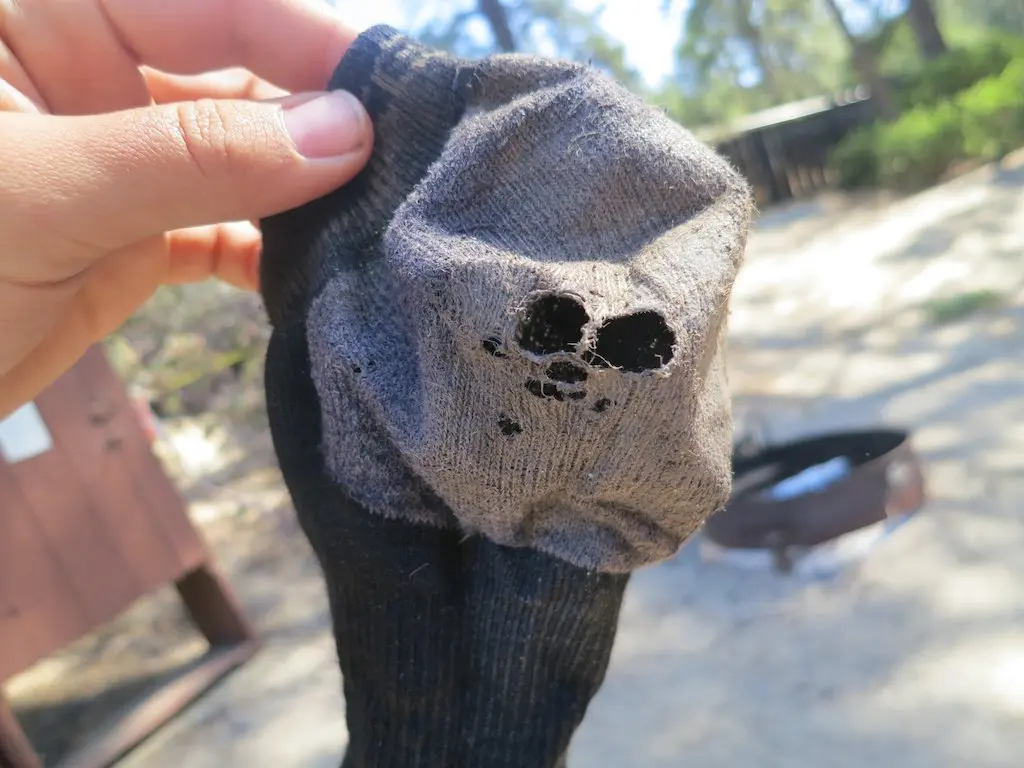

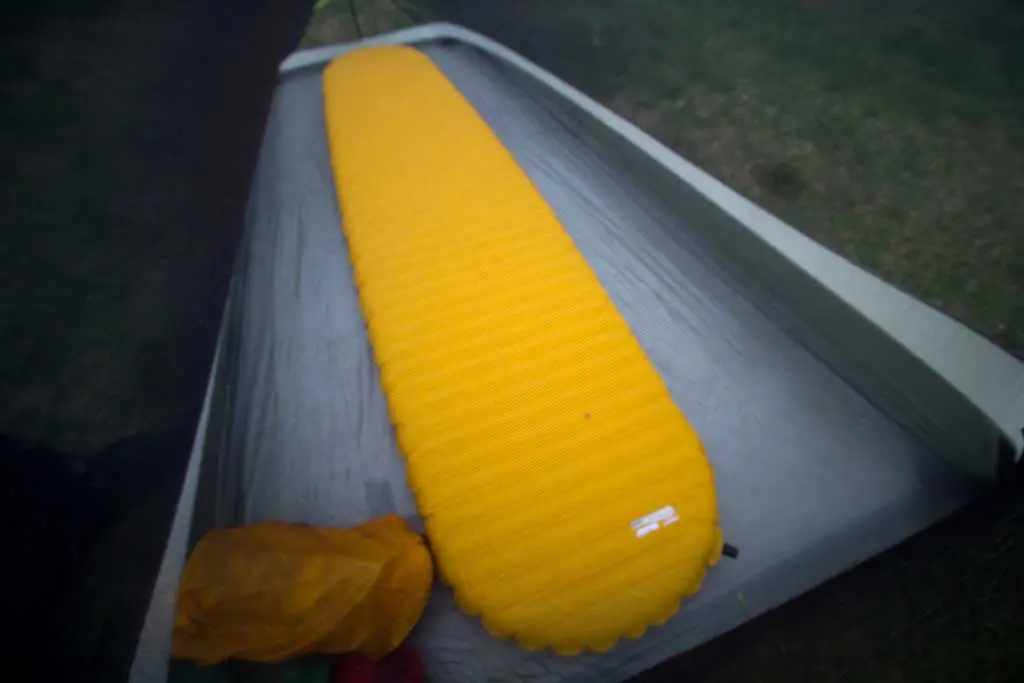



I took a Platypus QuickDraw Microfilter kit for a short section in New Mexico. Astounding volume of filtered water when it’s new, like the first four liters. The volume decreased, but the shaking backwash of the dirty end worked to increase volume after gross cow ponds.
On the other hand, the wide-mouth bladder split on the seam where the thin stuff joins the thick neck. I had dirty water running down the filter, my hands, and the clean bladder below. It seems inevitable that dirty water also got into the filtered water. So, I’d filter the grossest water and then add AquaMira.
I’d consider getting another QuickDraw after returning my first. I’d still get the kit, but I’d be prepared to use a different bladder when the time came. Platypus does not sell the wide-mouth bladder separately.
Oh, and RTFM: Before initial use, the filter needs to be soaked.
Excellent to know! I usually use it with a bottle instead of the bladder so I haven’t had enough time to destroy one yet.
Hi. Thanks very much for this! Very informative. Just wondering, if the cap lid did break on the clean side, is it possible to unscrew it and replace it with a completely different cap lid from, for example, a sports or smart water bottle? (like what some folks do with the Sawyer filters?) (Wasn’t sure from the photos alone.)
I have not had any issues with the clean side cap falling off. It is not possible to remove/replace it.
Thanks! :)
Hi Mac. I was just seeing a video from Platypus about how to do the integrity test for the filter. I noticed that the woman in the video removed the end for the clean side by unscrewing it, so that the fibers inside were exposed for the integrity test. I wonder if that threading for the clean side is also 28mm. If so, then a person should be able to replace the clean cap by unscrewing and putting another cap on (e.g. a SmartWater bottle cap), right? Maybe also one of those tornado/vortex bottle connectors. Any chance you might be able/willing to unscrew the clean end on yours, to check if it’s a 28mm threading on that side?
The clean side threads are not 28mm and will not fit another cap – the clean side it both too wide in diameter and has too thin of threads to fit something like a SmartWater bottle cap.
Aww nuts. Well, thanks a bunch for the info, though. I really appreciate it as it’s been confusing for us to figure out what the best choice would be for our emergency kits.
I’m wondering if it’s possible to save a few grams by taking the caps off. Any reason they need to stay on?
Also Sawyer squeeze usually comes in under spec- I’ve heard most are around 2.5 oz, that’s what mine is too.
Thanks for reviewing this in detail. I’m surprised there isn’t a ton of stuff out there about this yet, most aren’t really deep dives.
You could remove the caps to save weight, yes. I like having them so I can easily close it up and not have it drip inside my sleeping bag if I need to put it in there overnight to prevent it from freezing.